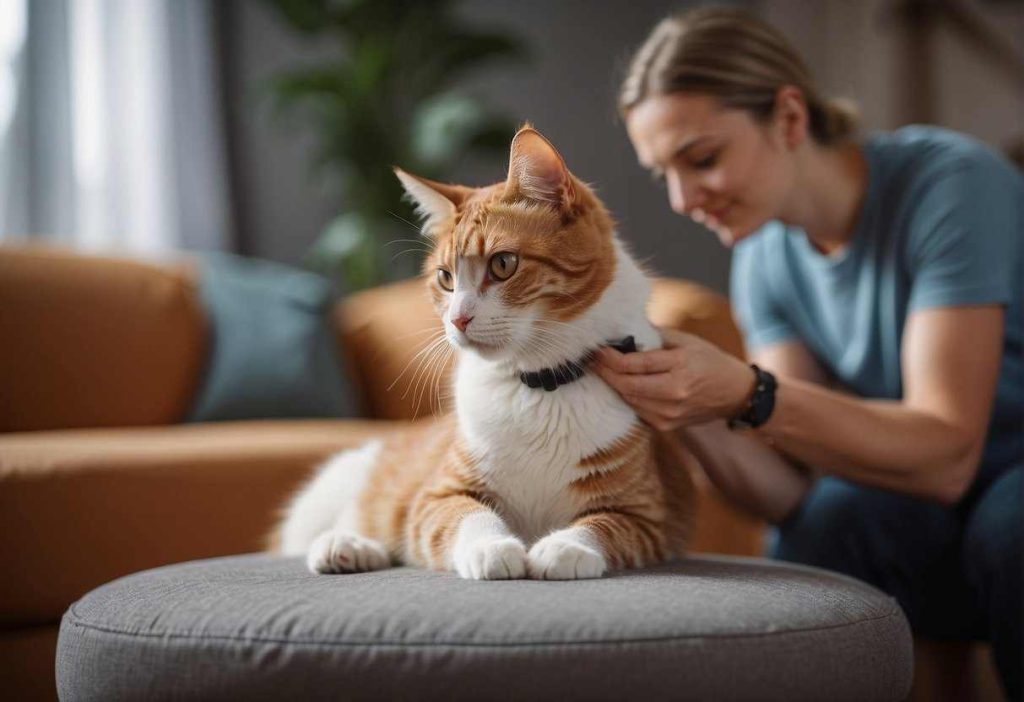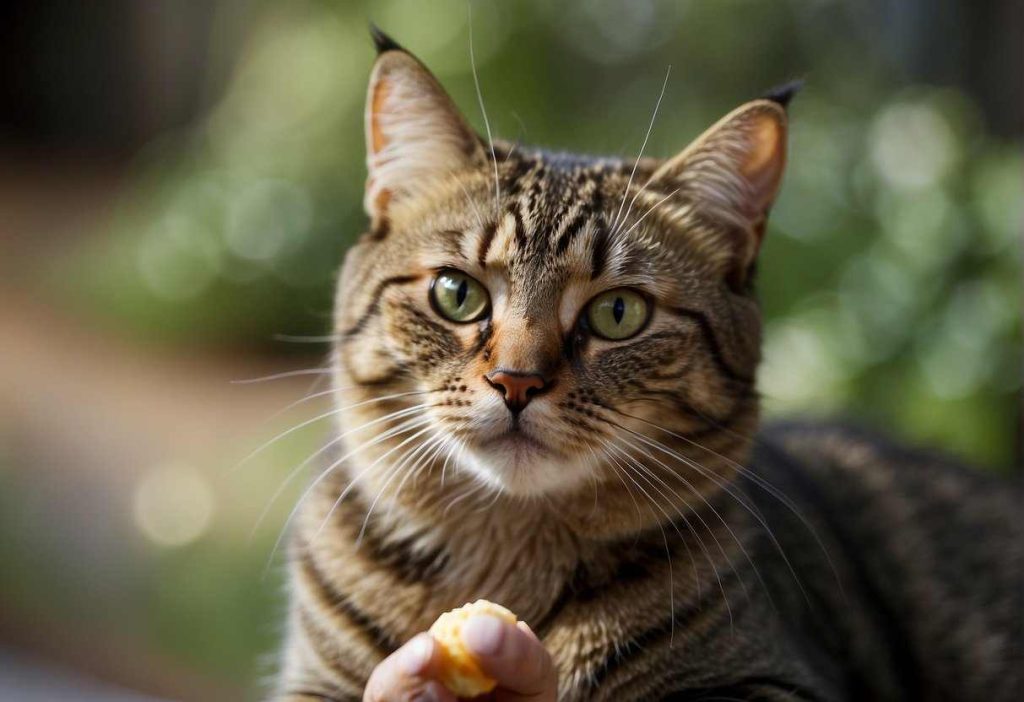Training your cat to sit on command is not only a party trick but also a useful behavior that can enhance your bond with your feline friend.
Cats are known for their independence, but with the right approach, even your free-spirited cat can learn this simple command.
So, how to teach a cat to sit successfully?
It’s all about understanding your cat’s behavior and finding what motivates them. Starting with their favorite treats and a calm training environment can set you both up for success.

Patience and repetition are key in teaching your cat to sit. Every cat has a unique personality, so what works for one may not work for another.
Introduce the command “sit” with a treat held just above their head, and as their gaze follows the treat upwards, their bottom will naturally lower.
Gently press down on their hindquarters if they need a little guidance. Reward them immediately after they sit to reinforce the behavior.
Remember, the well-being of your cat during training sessions is paramount; keep sessions short and stress-free.
Key Takeaways
- Training your cat to sit builds your bond and has practical benefits.
- Use treats and patience to guide your cat into the sitting position.
- Ensure training is a positive experience and address any challenges promptly.
How to Teach a Cat to Sit: Basic Steps
Preparing for Training
Choose a quiet room where your cat feels comfortable, with few distractions. This will help keep your cat focused on you.
Essential Equipment for Training
Step-by-Step Training Process
- Step 1: Lure Your Cat into Position
- Hold a treat just above their head, and gently guide your cat into a sitting position. Cats are natural negotiators, so they might take a moment to consider the offer!
- Step 2: Introducing the Command
- As your cat’s haunches touch the ground, say “Sit”. Keep it clear and upbeat! Imagine you’re offering the best deal of their nine lives. (3)
- Step 3: Reinforcing the Behavior
- Once they sit, immediately give them a treat and praise them. It’s like hitting the jackpot on a slot machine for your cat! (4)
Repeat these steps regularly, but keep training sessions short—cats have a “to-do” list, too!
Remember, patience is key, and soon your cat will be sitting like a pro.
Ensuring Your Cat’s Well-being During Training

When teaching your cat to sit, it’s crucial to make the process enjoyable for both you and your feline friend.
Positive reinforcement is your secret weapon! Every time your cat performs the desired action, reward them immediately. (5)
Use their favorite treats, and they’ll associate sitting with savory goodies. Keep an eye out for stress indicators.
Is your cat’s tail twitching aggressively? Are their ears pinned back? These signs suggest they’re not feeling the training vibe. If that happens, it’s time for a break!
Remember, short and frequent training sessions are better than long and exhausting ones; your cat’s comfort should never take a back seat.
Key Points for Feline-Friendly Training:
- Observation: Pay attention to your cat’s body language. (6)
- Consistency: Use the same command and reward system.
- Patience: Sometimes it takes a while, and that’s okay!
| Behavior Indicating Stress | Action to Take |
| Ears pinned back | Give your cat a timeout |
| Tail flicking | Reassess the training pace |
| Hiding or avoidance behavior | Offer comfort and a safe space |
Keep sessions short, wrap them up in about 5–10 minutes, and aim to practice two to three times daily. The goal is to build a positive association without overwhelming your pal.
Good job, and remember, a happy cat equals a happy life!
Troubleshooting Common Training Challenges

Common Issues and Solutions
- Cat doesn’t respond: Your furball may ignore you. Stay patient. Reassure with a gentle voice and retry.
- Distractions: Too much going on? Find a quiet training spot to keep the kitty focused.
Keeping the Cat Engaged
- Short Sessions: Cats have short attention spans. Keep training sessions between 5-15 minutes.
- Playtime: Sometimes, a little play before training helps burn off extra energy. (7)
Varying Training Routines
- Routine Change: Mix up the training routine so it stays fresh. Surprise your cat with new tricks or commands to follow.
Using Different Types of Rewards
- Different Treats: If your cat loses interest in their usual treat, switch it up. Try a new flavor or a different type of reward, like a few minutes of cuddle time.
- Non-food Rewards: Sometimes praise or a quick play session can be just as effective as treats.
Remember, cats are individuals, and what works for one may not work for another.
Stay attuned to your cat’s preferences and comfort levels. Keep things upbeat and make training a positive experience. If something isn’t working, it’s okay to take a break and try again later.
Your patience and consistency will eventually pay off with a cat that sits on command.
Advanced Training Tips

Building upon the “sit” command
- Step-by-Step Rewards:
- Start with the basics. Ensure your cat has the ‘sit’ command down pat.
- Incrementally increase the challenge. After ‘sit,’ wait for two seconds before rewarding.
- Gradually extend the waiting period to reinforce self-control.
- Distraction Training:
- Introduce new sounds or toys in the environment.
- Practice ‘sitting’ amid these distractions to boost focus.
Tailoring Training to Your Cat’s Personality
- For the Shy Feline:
- Keep training sessions short and stress-free.
- Use a soft voice and gentle petting to reassure them.
- For the Playful Prowler:
- Incorporate playtime into the training.
- Use feather wands or laser pointers to catch their attention, then transition to ‘sit’.
- For the Independent Thinker:
- Patience is key; work with their mood.
- Try puzzle feeders as a reward for sitting on command.
Remember, every cat is an individual. While one trick might work wonders for Mr. Whiskers next door, your kitty might scoff and request a more personalized approach.
Keep sessions engaging, and don’t forget to enjoy this bonding time – it’s not just about obedience; it’s about strengthening your camaraderie.
Want to make your cat the star of the next cat café gathering? Consistency and patience will get you there!
Maintaining and Enhancing Training

Keeping Training Sessions Engaging:
- Change it up: Rotate the treats you offer to keep your cat curious and eager.
- Short and sweet: Cats have short attention spans, so aim for 5-10 minutes per session.
- Be playful: Use toys to make training feel like a game.
Advanced Commands and Tricks:
Once sitting is a breeze, why not raise the bar? You could introduce ‘high five’ or ‘roll over’.
Remember, patience is your best friend (next to your cat, of course!).
| Step | Advice |
| New Challenges | Gradually increase the difficulty of testing your cat’s skills. |
| Positive Reinforcement | Praise and treat for each success, no matter how small. |
| Repeat | Practice makes purr-fect. Keep at it regularly. |
Wondering about the perfect treat for your savvy feline? Each cat is different, just like us—they might love a classic crunchy treat or prefer a sliver of chicken.
Just pay attention to their preferences, and you’ll be golden.
You’ve got this! Remember to be patient and to keep things fun. Who knew training could be such a tail-wagging good time? Happy training!
Additional Resources

The web is a treasure trove of tips and tales from fellow cat enthusiasts.
- Websites and Blogs: Cat Behavior Associates: A site run by certified cat behaviorists.
- The Conscious Cat: Insights on cat behavior and training.
- Modern Cat: Your guide to everything cat!
Feeling social?
Join online forums or Facebook groups like ‘Cat Training Enthusiasts’ or ‘Feline Behavior Forum’ to swap stories and strategies with other cat owners.
- Books:“The Trainable Cat” by John Bradshaw & Sarah Ellis. It’s hailed as a handbook for creating a happy partnership with your kitty.
- “Cat Training in 10 Minutes” by Miriam Fields-Babineau. It’s packed with quick training sessions for your busy day.
Also, remember those YouTube cat influencers? Yes, they exist, and they’re eager to show off their sitting skills!
Check out channels like ‘Cat School’ – who knew kitty could have homework, right? Don’t forget to give these practices a shot, and your furry friend will be sitting pretty in no time!
Keep it fun, patient, and rewarding – literally. Cat got your tongue, or need a visual guide? Look for instructional videos that cover the A-Z of cat sitting.
Keep those training treats handy and happy training!
Quick Recap

You’ve taken the first step toward teaching your feline friend an adorable new trick: sitting on command.
Remember, patience is key; cats aren’t known for their love of obedience, but with positive reinforcement, they’ll come around.
Key Steps:
- Choose a quiet training spot.
- Keep sessions short, about 5 minutes.
- Equip yourself with your cat’s favorite treats.
- Pair the command “Sit” with a hand signal.
- Press gently on the cat’s backside while saying “Sit”.
- Reward immediately after the desired action.
- Practice consistently but don’t overdo it.
Progress Measurement:
- Day 1-3: Introduce the command and treat.
- Day 4-6: Reinforce with repetitive practice.
- By Day 7: Some cats may begin sitting on command.
Do you have questions or hitting a snag?
Troubleshooting guides and video tutorials are just a quick search away. They can provide a visual aid and additional tips from seasoned cat trainers.
Feeling proud of your progress?
Share a cute pic of your sitting kitty and tap into the cat-loving community’s experience for further advice or a well-deserved “paw” on the back.
If your cat seems more stubborn than some, keep at it! Every meowster has its pace. Remember, you’re not just teaching a trick; you’re bonding and building trust.
P.S. Don’t forget to brag a little when your cat masters this trick; after all, who wouldn’t be impressed by a sitting cat, right?
Keep it fun, keep it light, and cherish every little victory along the way!
Frequently Asked Questions

Wondering about teaching your furry friend the ‘sit’ command? You’re in the right spot! Here’s the lowdown on the most common curiosities cat owners have about this process.
Can any cat learn to sit on command?
Sure can! While some breeds may pick it up quicker than others, with patience and consistency, just about any kitty can learn to sit when you ask.
How long does it take to teach a cat to sit?
Each cat is unique, so this can vary. Typically, it takes a few days to a couple of weeks of regular training sessions.
Aim for short but frequent practice to keep it fun.
What are the best treats to use for training a cat to sit?
Go for small, tasty treats that your cat goes bonkers for! The more delicious the treat, the more your cat will be willing to work for it.
Soft treats are often easier and faster to eat which keeps training snappy.
How many times a day should I practice the ‘sit’ command with my cat?
Two to three times a day should do the trick.
Keep sessions short—around 5 minutes each—to keep your cat engaged and prevent boredom.
What should I do if my cat refuses to sit during training sessions?
Don’t sweat it; patience is key. Never force your cat into a sitting position. Instead, take a break and try again later.
Sometimes, revisiting training when your cat is more responsive, such as before meal times, can help.
Is it okay to use a clicker for training my cat to sit?
Absolutely! Clicker training can be super effective. It helps your cat understand exactly when they’ve done the right thing.
Click the moment your cat’s bottom touches down, then follow up with a treat.
How can I keep my cat engaged during training sessions?
Mix it up to keep it interesting! Rotate between different treats, change up the training environment, and vary the time of day.
Plus, keep those sessions brief and end on a positive note to leave your cat eager for more.
- Advantages of Playing Casino Online - July 6, 2025
- How players can take advantage of the no deposit bonus at the Casino - July 5, 2025


